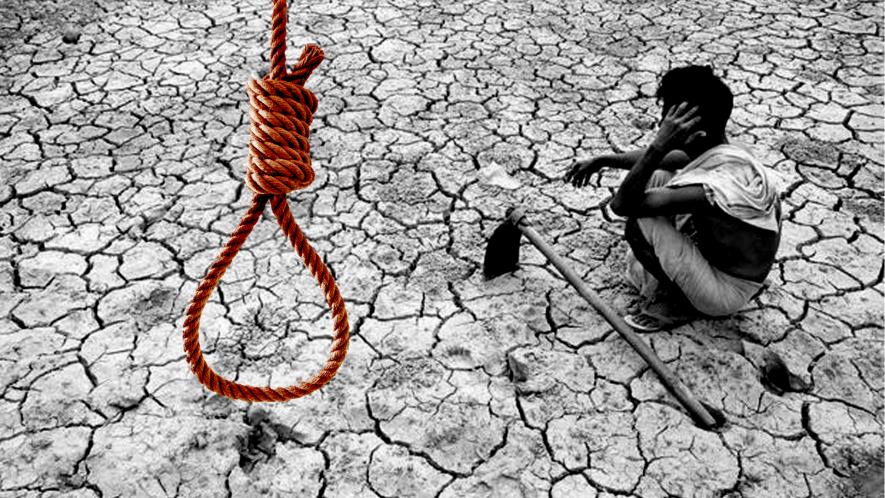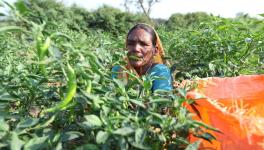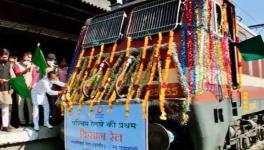Kisan Mukti Sansad Nov 20-21: Farmers To Demand One-Time Total Debt Waiver at Delhi Protest

Image by Newsclick
On 20-21 November, farmers from all over the country are gathering at Delhi in a historic Kisan Mukti Sansad (Farmers’ Liberation Parliament). Two of their key demands are: better prices for produce and debt relief. These two are interlinked: farmers get indebted because, among other things, they don’t get adequate prices for what they produce. The scale of indebtedness of India’s farmers is mind boggling, all the more so because it is they who provide food for all Indians. In the Sansad, families of those farmers who were forced to commit suicide will also participate.
In last 10 years, India’s food production zoomed up from 365 million tons in 2005-06 to 534 million tons in 2015-16. This includes food grains, and vegetables and fruits. In the same period, an estimated 150,000 farmers committed suicide according to farmers’ organisations because of inability to pay back their loans or suffering crop losses. Needless to say that for every tragic suicide, there will be hundreds more who are in similar indebted situations.
According to NSSO survey reports, the share of indebted households among cultivator households rose from 25.9% in 1992 to 45.9% in 2013. Average debt per rural household was over Rs.70,000, but if the average is taken among the indebted households only, it shoots up to over Rs.1.5 lakh per household. Lest you think that the debt is being used for assets, like land or machinery, the data for debt-asset ratio dispels this illusion: debt-asset ratio increased from 1.61 in 1992 to 2.46 in 2013. This means that debt has increased far beyond what the households own as assets. This is because a large proportion of debt is incurred for working expenses like buying seeds, fertilizers, etc.
Another NSSO survey points out that about 40% of loans are taken from non-institutional sources like professional money lenders and shopkeepers. The interest rates charged can be as high as over 30%, with more than a third of farmers owing money to professional lenders carrying the burden of that kind of usurious rates. According to the All India Kisan Sabha, farmers have been forced to borrow from moneylenders, fertilizer, pesticide and seed dealers, and loan sharks at interest rates as high as 36% to 60% per annum. Moreover, analysis has shown that bank loans are mostly cornered by big land owners leaving the poorer sections at the mercy of loan sharks.
All this has led to a wave of pauperization of the farming community, especially the small and medium level farmers who have no resources to fall back upon and keep getting deeper and deeper into debt. It is notable that while the government is changing laws to make it easier for companies to go ‘bankrupt’ and thus escape repayment of loans, there is no such facility for farmers. Uncertainty faced by farmers is far greater than any other enterprise. They can face crop losses due to lack of rainfall, excessive rainfall, unseasonal rainfall, hailstorms, storms and high winds, pest attacks etc. With changing climate such events are becoming increasingly frequent. Yet no loan is ever written off. This practice of ‘non-recourse loans’ exists for farmers in many other countries.
The govt. is trying to ‘solve’ the problem of crop losses by foisting an insurance scheme. But last year’s performance shows that a large share of farmers are left out, claims are not settled – and the private players are making thousands of crores out of the whole set-up by guzzling the govt.’s settlement amounts.
It is in this background that farmers have been agitating for the past several years and are now congregating at Delhi under the banner of the umbrella forum of All India Kisan Sangharsh Coordination Committee (AIKSCC). Among their demands in relation to debt are a one-time waiver of outstanding crop loans of all farmers as of May 31, 2017, debt relief from private (non-institutional) agricultural loans of farmers through the establishment of Farmers’ Debt Relief Commission. This should include settlement of private loans as well as debt swapping to convert private loans into bank loans, a time-bound inclusion of all cultivators, including marginal farmers, tenant farmers and sharecroppers into institutional credit system within the next 2 years, an effective system of disaster relief and crop insurance so that farmers clear most of their debt even in a bad year and, to avoid penalizing the farmers who repaid their crop loans on time, a credit to the bank accounts of small farmers equal to the amount of crop loan repaid in the previous season.
Get the latest reports & analysis with people's perspective on Protests, movements & deep analytical videos, discussions of the current affairs in your Telegram app. Subscribe to NewsClick's Telegram channel & get Real-Time updates on stories, as they get published on our website.
























